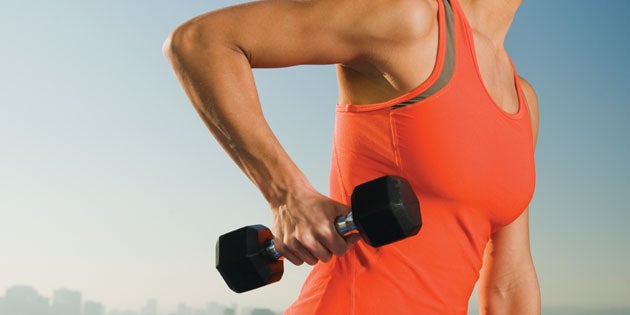Heading out the door? Read this article on the new Outside+ app available now on iOS devices for members! Download the app.

When it comes to losing weight there are no gimmicks. The formula is simple: if you want to burn calories, you need to rev up your metabolism — a set of chemical reactions that happen right inside your body that help control the rate at which you burn energy (ie: calories!). Keeping your metabolism revved is the best way to burn more calories and torch belly fat. So get started today by following these 10 strategies and get the body you’ve always wanted.
1. Build Muscle Through Strength Training.
“Unlike fat, muscle is metabolically active tissue,” says Carla Sanchez, CPS and IFBB Pro, founder and trainer of the Colorado-based Performance Ready fitness, figure and bikini team. That means the more muscle you’ve got, the more calories you’ll burn even when you aren’t exercising. To start out, aim for two to three days of strength training per week, remembering to keep increasing the amount of weight you’re lifting (while keeping good form).
2. Eat More Often.
Think of your body as a machine that needs a constant energy source (food) for fuel. Stop feeding it and it’s going to run sluggish. “Keep the engine stoked throughout the day,” says Dallas-based sports nutritionist Jennifer Neily, MS, RD, CSSD. There are three benefits to eating five to six smaller meals (composed of healthy fat, lean protein and complex carbs). First, it takes about 10 percent of the calories in your food to digest it (so you burn 25 calories by digesting 250 calories), so eating more frequently helps rev the engine. Second, you’ll have more energy to be active, and third, you’re less likely to reach for a sugary, snack when you’re keeping your blood sugar steady.
3. Get Enough Iron.
Iron is what helps transport oxygen to your cells, and it’s tied in closely with your energy levels. “People who are anemic (deficient in iron) lack energy,” Neily says. Women between the ages of 19 and 50 need 18 mg of iron daily, but be careful of taking iron supplements (unless directed by your doctor) because too much can be toxic. Instead, get it through your diet by consuming foods such as beans, fortified cereal and prune juice (which has more iron than dark chicken meat, Neily says). Cooking in an iron skillet will also add some iron to your food.
4. Stay Hydrated.
Your body needs water to help it digest and convert food efficiently into energy. “Keep your metabolism at its peak by getting enough fluid,” Neily says. Aim for about two to three liters of fluid every day, and don’t forget to add water-rich fruits and vegetables to your diet as well. Some of your best options? Cucumber, melons and zucchini.
5. Refuel After Your Workouts.
You may think that not eating after a hard workout will help you shed pounds, but refueling after exercise plays a big role in metabolism and fat loss. Before you reach for an expensive energy drink, consider this: According to a recent McMaster University study, women who drank fat-free milk after each session of strength training (for 12 weeks) increased their fat loss more than women who drank carbohydrate sports drinks afterward. Prepare your postworkout snack before you start your gym session. This way you’re sure not to skip it.
6. Pack More Protein.
Your body uses more energy to digest protein than fat and carbohydrates, Neily says, so it makes your metabolism work harder (not to mention protein also helps keep hunger pangs away). Active women who strength train and perform cardio regularly need about a gram of protein per pound of body weight, so add lean sources of protein such as poultry (without skin), fish, beans and low-fat dairy to your diet.
7. Avoid Alcohol.
“When alcohol enters your body, it acts like a VIP,” Neily says. Your body rushes to meet its demands, which includes being metabolized first. That means that other food is less likely to get used for energy and gets stored as fat. Not only do you not metabolize fat as efficiently when you’re imbibing, you’re also likely to eat more junk when your good judgment is thrown off.
8. Ditch Crash Diets.
Diets that tout miracle fat loss — and products that claim to radically change your metabolism — are full of empty promises. It’s not about starving yourself, loading up on caffeine or cutting out entire food groups. It’s about quality calories and burning more calories than you consume on a daily basis, Neily says. Steer clear of short time frames, missing nutrients and fancy infomercials. Clean eating is your top strategy for a boosted metabolism.
9. Spice Up Your Diet.
Research indicates that adding capsaicin (a compound found in the seeds and membranes of hot peppers) to your diet could help increase your metabolism through a process called thermogenesis. Here’s how it works: When you eat chili peppers, your body generates heat, and as your temperature increases, so does the number of calories you burn. So toss peppers into your stir-fries, salads, casseroles, soups and sauces.
10. Kick Up Your Cardio.
Short duration, high-intensity bursts of exercise for just two weeks improves fat loss by 36 percent, according to a study from the University of Guelph in Ontario, Canada. Plus, Sanchez says, when you do this type of interval training (such as sprinting for one minute, with one to two minutes recovery, repeated for 15 to 20 minutes), your body will continue to burn calories and fuel for a longer period of time — meaning that after your sugars are tapped out, it reaches for the fat stores. The same amount of time spent on low-intensity exercise won’t have the same after-burn effect.